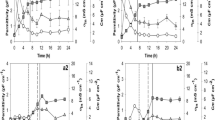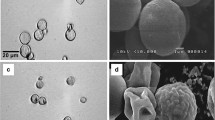Abstract
The decrease rate of the water potential was found to have a great effect on yeasts submitted to hypertonic shifts. The application of slow and linear decreases of the water potential of the medium to cells of Saccharomyces cerevisiae demonstrated that the cells could survive (90 to 100% of viability) very low levels of water potential (Ψ=−101 MPa). Resistance of the cells was examined through viability measurements and cell volume changes. The kinetics of cell volume variation were measured continuously using an on-line image analysis system coupled to a microscope. No biological response of the cells occurred, due to the lack of a usable carbon-energy source in the medium. The viability level was found to be a function of the water exit flow rate from the cells. The denaturation of the membrane structure was assumed to be involved in such phenomena.
Similar content being viewed by others
References
Berner JL, Gervais P (1994) A new visualization chamber to study the transient volumetric response of yeast cells submitted to osmotic shifts. Biotechnol Bioeng 43:165–170
Brown AD (1974) Microbial water relations: features of the intracellular composition of sugar-tolerant yeasts. J Bacteriol 118:769–777
Brown AD (1990) Microbial water stress physiology. Principles and perspectives. Wiley, Chichester
Brown AD, Edgley M (1980) Osmoregulation in yeast. In: Rains DW, Valentine RC, Hollaender A (eds) Genetic engineering of osmoregulation. Plenum Press, New York, pp 75–90
Chirife J (1994) Specific solute effects with special reference to Staphylococcus aureus. J Food Sci 22:409–419
Chirife J, Resnick SL (1984) Unsaturated solutions of sodium chloride as reference sources of water activity at various temperatures. J Food Sci 49:1486–1488
Christian JHB (1981) Specific solute effects on microbial water relations. In: Rockland LB, Stewart GF (eds) Water activity: influences in food quality. Proceedings of 2nd International Symposium on Properties of Water affecting Quality. Academic Press, London pp.825–854
Clegg JS, Seitz P, Seitz W, Hazlewood CF (1982) Cellular responses to extreme water loss. The water-replacement hypothesis. Cryobiology 19:306–316
Crowe JH, Crowe LM (1982) Induction of an hydrobiosis membrane changes during drying. Cryobiology 19:317–328
Edgley M, Brown AD (1983) Yeast water relations: physiological changes induced by solute stress in Saccharomyces cerevisiae and Saccharomyces rouxii. J Gen Microbiol 129:3453–3463
Gennis RB (1989) Biomembranes: molecular structure and function. Springer, Berlin Heidelberg New York
Gervais P, Maréchal PA (1994) Yeast resistance to high levels of osmotic pressure: influence of kinetics. In: Fito P, Mulet A, McKenna B (eds) Water in Foods. Proceedings of the 5th International Symposium on Properties of Water, 8–14 November 1992, Valencia, Spain. Elsevier Applied Science, London New York, pp 399–408
Gervais P, Maréchal PA, Molin P (1992) Effects of the kinetics of osmotic pressure variation on yeast viability. Biotechnol Bioeng 40:1435–1439
Griffin DM (1981) Water and microbial stress. Adv Microb Ecol 5:91–136
Kedem O, Katchalsky A (1958) Thermodynamic analysis of the permeability of biological membranes to non-electrolytes. Biochim Biophys Acta 27:229–246
Levin RL (1979) Water permeability of yeast cells at sub-zero temperature. J Membrane Biol 49:91–124
Macey RI, Brahm J (1989) Osmotic and diffusional water permeability in red cells: methods and interpretations. In: Benga G (ed) Water transport in biological membranes, vol 2. CRC Press, Boca Raton, Fla. pp 25–126
MacKenzie KF, Blomberg A, Brown AD (1986) Water stress plating hypersensitivity of yeasts. J Gen Microbiol 132:2053–2056
Morris GJ, Winters L, Coulson GE, Clarke K (1986) Effect of osmotic stress on the ultrastructure and viability of the yeast Saccharomyces cerevisiae. J Gen Microbiol 129:2023–2034
Munns R, Greenway H, Setter TL, Kuo J (1983) Turgor pressure, volumetric elastic modulus, osmotic volume and ultrastructure of Chlorella emersonii grown at high and low external NaCl. J Exp Bot 34:144–155
Niedermeyer W, Parish GR, Moor H (1977) Reactions of yeast cells to glycerol treatment. Alterations to membrane structure and glycerol uptake. Protoplasma 92:177–193
Norrish RS (1966) An equation for the activity coefficents and equilibrium relative humidities of the water in confectionery syrups. J Food Technol 1:25–39
Rose AH (1976) Osmotic stress and microbial survival. Symp Soc Gen Microbiol 26:155–182
Steponkus P (1987) Membrane destabilization resulting from freeze-induced dehydration. Cryobiology 24:555
Watanabe Y, Takakuwa M (1987) Change of lipid composition of Zygosaccharomyces rouxii after transfer to high sodium chloride culture medium. J Ferment Technol 65:365–369
Yancey PH, Clark ME, Hand SC, Bowlus RD, Somero GN (1982) Living with water stress: Evolution of osmolyte systems. Science 217:1214–1222
Zimmermann U (1978) Physics of turgor and osmoregulation. Annu Rev Plant Physiol 26:121–148
Author information
Authors and Affiliations
Rights and permissions
About this article
Cite this article
Marechal, P.A., Gervais, P. Yeast viability related to water potential variation: influence of the transient phase. Appl Microbiol Biotechnol 42, 617–622 (1994). https://doi.org/10.1007/BF00173929
Received:
Revised:
Accepted:
Issue Date:
DOI: https://doi.org/10.1007/BF00173929




